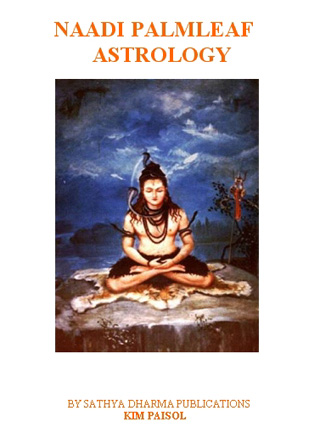This is
the ultimate and very comprehensive book about the Naadi
Astrology, its spiritual origin, development and reason.
The book contains a great number of samples from different
kinds of Naadi collections throughout India and everything
explained and understood as a Divine game, where the illusion
of karma and destiny is a state of mind only to be changed
accordingly as one “rediscovers” ones own true Divine
Self
The book also contains readings of ordinary, people,
saints and Avatars.

INDEX of the book is like this:
Forward: 6
Preface: 8
Chapter 1. Introduction – The Kali Yuga Linga Purana:
Vishnu Purana 10
Chapter 2. The Naadi Palm Leaves 24
Chapter 3. Ganesh and Sakti Naadi 33
Chapter 4. Naadi´s and Astrology 51
Chapter 5. Saint Bhrigu. Own reading Delhi 1993 (Bhrigu,
Agastya and Vashista Naadi readings)
Chapter 6. Bhrigu Samhita in Denmark 1994 81
Chapter 7. Delhi 1994 and South India. 85
Chapter 8. Ganesh and Sakti Naadi September 1994 93
Chapter 9. Return to Denmark, October 1994 98
Chapter 10. India, February 10th 1995 101
Chapter 11. Vaitheesvarankoil, Shiva Sukshma Naadi 106
Chapter 12. Siva Sukshma Naadi 1995 (Own reading) 113
Chapter 13. Readings with the Ganesh Naadi 121
Chapter 14. Chennai, March - April 1995 129
Chapter 15. Chennai, April - May 1995. Sara’s Reading
137
Chapter 16. Chennai 1995. Ganesh Naadi 143
Chapter 17. Lal Bahadur Sastris Bhrigu Reading 149
Chapter 18. India December 1995 153
Chapter 19. Bhrigu readings. February 1997 157
Chapter 20. Hanuman Naadi 165
Chapter 21. Remedies, change of Karma and Destiny 179
Chapter 22. Different readings 186
Chapter 23. Agastya Prasna Jeeva Naadi 242
Chapter 24. Experiences with spiritual people and Naadi´s
274
Chapter 25. Agastya Koushika Naadi 294
Chapter 26. Siddhis and Vidya´s 342
Chapter 27. Chakras 359
Chapter 28. Sai Baba 363
Chapter 29. Siva Shankar Baba 370
Chapter 30. Sri Bhagavan Ramana 378
Chapter 31. Sri Ramakrishna 395
Chapter 32. Ammachi 399
Chapter 33. Final 403
The first chapter of the book "Naadi Palmleaf Astrology":
Chapter 1. Kali Yuga
“The joy of worldly-minded people is derived from sense-objects,
from the enjoyment of lust and wealth. When in the course
of spiritual practice the Lord is pleased to manifest
Himself, then comes the highest enjoyment – the bliss
of Brahman”.
Sri Ramakrishna
Introduction
One of the most amazing phenomena in Indian astrological
literature is the Naadi Granthas or Samhitas (collections
of horoscopes and readings). In Southern India these are
written on impregnated palm leaves, in Northern India
most often on parchment-like paper or even on the skins
of various animals, yellowed and moldering with age. These
are collections created at the time of the beginning of
all things and created because the future destiny of the
earth and man, natural disasters and the consequent major
upheavals were all predicted in the distant past. All
spiritual as well as mundane knowledge was collected so
that this knowledge might later be divulged at the right
time and place.
This is part of the explanation given by the contemporary
Sri Swamiji Ganapathi Sachchidananda of Mysore.
Sri Ganapathy performing Dhana Lakshmi Puja on Deepavali
- 2005
Yugas
Ancient Vedic scriptures reveal the conception of cycles
or Yugas regulated by the Galactic Center. These are cycles
of Sarga (Creation) and Pralaya (Dissolution) and reflecting
Brahma the Creator, where one of His cycles represents
4.320,000 years of Brahma. Also this can be seen in different
Puranas and the Mahabharata. The scriptures divide a cycle
into four different time ages or MahaYugas. First Satya
Yuga, which lasted 1,728,000 years, then Treta Yuga of
1,296,000 years, then Dwapara Yuga of 864,000 years, and
finally Kali Yuga, the present age of 432,000 years, which
started the night between the 17th and 18th of February,
year 3102 BC, corresponding to the time when Lord Krishna
leaves his form after his stay of 125 years, 7 months
and 9 days. The further back in time we go, the more enlightened
and pure were the humans, but a gradual moral degrading
will take place Yuga by Yuga and when our present Kali
Yuga age expires, everything will start over again; this
is a part of the cycle or function of the universe.
Modern science and the theory of the “Big Bang” and the
expanding Universe corresponds well with the above.
Lord Krishna also says in Bhagavad Gita: “This material
nature which is one of My energies, is working under My
direction, - Producing all moving and nonmoving beings.
Under its rule this manifestation is created and annihilated
again and again.”
The Kali Yuga itself is further divided into six sub-periods,
of which the first, Yudhishtara Shaka lasted 3,044 years.
The second Vikram Shaka, lasted 135 years and the present
Shalivahan Shaka, will last 18,000 years. Then follows
Vijayabhinandan Shaka, lasting for 10,000 years. After
that Nagarjun Shaka lasting 400,000 years and finally
Kalki Shaka, which will last 821 years.
According to our calendar, in the year 2000, the present
Kali Yuga has lasted 5,175 years. During the present sub-period
of Shalivahan Shaka we will see brief periods also called
for “Golden Ages”, where genuine religious belief will
flourish and also certain Avatars will take birth to guide
and direct devotees to realize the “Golden Age” within,
but basically the unfortunate results described below
will increasingly characterize the Kali Yuga. |